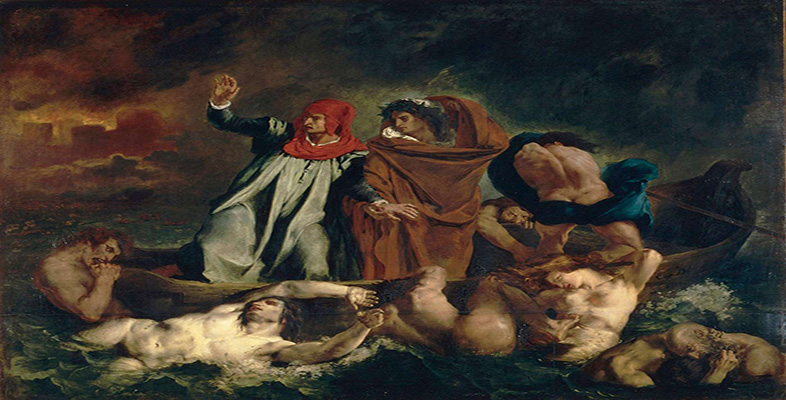5.9 A reaction to the bourgeois establishment
Delacroix made many satirical drawings that expressed his criticism of the monarchy (even its more liberal incarnation in the form of Louis XVIII), aristocracy and clergy, and that made clear his sympathies with Bonapartist Liberalism. For example, the Goya-esque Plate 27 (probably inspired by the anti-clerical satire in Los Caprichos) and Plate 28. Also look a Plate 38, Acrobats’ Riding Class (1822). The latter depicts incompetent Ultra riders wearing ancient armour, clerical dress and ancien regime court attire. They fall off their horses as two demure figures look on from the middle. These are a Napoleonic cavalryman whose banner reads ‘Glory, Honour, Fatherland’, and a good bourgeois whose banner proclaims ‘Fine Arts, Industry, Commerce, Talent and Virtues’. If Stendhal’s modernity had found expression within the sphere of Napoleonic politics, Delacroix’s defined itself in response to what he saw as the conservative, pro-classical and pro-monarchy academies (such as the Academy of Fine Arts: The French Royal Academy, abolished in 1793, had two years later become the National Institute of Sciences and Arts. In 1816 the separate schools of this institute, including what became the nineteenth century Academy of Fine Arts, were restored to direct royal protection) and those bourgeois who supported the reactionary Charles X. He abhorred their dislike of Voltaire and Rousseau, two of the Enlightenment’s most eloquent critics of a corrupt monarchy, and found, in Stendhal and others, welcome exponents of a new aesthetic. Indeed Sardanapalus, with its defective ruler, has been interpreted as a ‘grand moral fable meant to indict absolutism’ (Athanassoglou-Kallmyer, 1991, p.111). Victor Hugo certainly perceived the relevance of the painting for the conservative contingent of the contemporary bourgeois establishment. His view (expressed in April 1828) summed up the archetypal Romantic reaction to bourgeois philistines:
Click to see Plate 26: Francisco de Goya, They’re Hot [Tip: hold Ctrl and click a link to open it in a new tab. (Hide tip)]
Click to see Plate 27: Eugène Delacroix, Priests and Monks
Click to see Plate 38: Eugène Delacroix, Acrobats’ Riding Class
His Sardanapalus is a magnificent thing, and so gigantic that it is beyond small minds … this beautiful work … has not been successful with the bourgeois of Paris: the jeers of fools form a fanfare for glory.
(Quoted in Johnson, 1981, p.120; trans. Walsh; italics in the original)
Critics of the painting, however, also included some Liberals who were alienated on aesthetic rather than political grounds (Lambertson, 2002, pp.79–85).
In the early years of the nineteenth century Romanticism experienced many subtle changes of direction. Stendhal admired the stoical heroism of David’s paintings (see for instance Plate 5, The Lictors returning to Brutus the Bodies of his Sons), which became, for Delacroix, symbols of bourgeois reaction. With the constant call for innovation, rebellion and modernity came an ever-shifting set of priorities. Delacroix was not, by modern standards, radical in his politics. Later in his life, prompted by a further revolution in 1848 that brought about a republic in France, he said how much he disliked mass popular uprisings and regretted the destruction caused by the Revolution of 1789. His Liberty Leading the People had initially caused a stir because of its sympathetic and realistic treatment of the lower orders. Nevertheless, Delacroix won the cross of the Legion of Honour for this work and it was originally displayed in the Palais du Luxembourg, although it was taken down in 1832 as part of a conservative backlash against its vivid republican overtones. But the artist's later writings suggest that his principal allegiance was to the educated middle classes.
